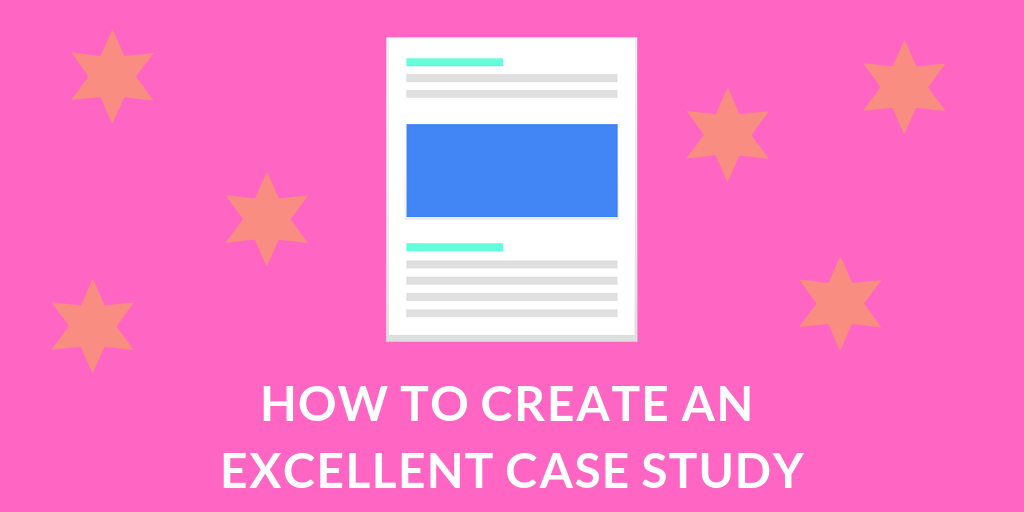About 73% of B2B companies produce case studies for their content marketing purposes. Also, 47% of them find case studies to be their most successful content types.
So what’s a marketing case study?
Simply put, a marketing case study (or a customer success story) is an advertorial for your business.
However, it doesn’t look or read like an advertisement.
Instead, it reads more like the story of how a company solved a problem using a particular solution provider or service. The most essential purpose of a marketing case study is to convince the reader that they can solve their problem just as the company in the case study did use the proposed solution.
Each time you want to push a lead further down your sales funnel or when you have a client that needs just a little more convincing to convert, you can send them a case study.
Let’s see a simple case study writing process and some tips to make your case studies more effective. We’ll also look at some good case study examples and formats.
Download a free case study template
Fill out the form below to get instant access to our case study template.
To save an editable copy, follow these simple steps:
- Click “File” in the top-left corner
- Click “Make a copy”
- Choose your destination folder
A step-by-step process for writing a case study
Here’s a simple 5-step process you can use to write your marketing case studies.
Step #1: Choose a company (or client) to feature in your case study
The first step to writing a case study is to pick a company to feature in it. This case study “candidate” can be any company or client you serve.
If you serve multiple audiences, choose a candidate from each. For example, at Filestage, we primarily serve two types of businesses:
- Creative agencies that produce visual content like videos
- Companies (like startups or small businesses or large enterprises) that create a lot of visual marketing collateral (graphics, videos or other content)
So, if we had to do a case study at Filestage, we could choose any of these audiences to feature in our case study.
In fact, we can even drill one level deeper into our selection process of case study candidates.
For instance, we can select one case study candidate for our agency customers that create only graphic content. Moreover, one case study candidate for our agency customers that create only video content.
Likewise, from our company customers, we can select different case study candidates based on the company size, its industry and so on.
Later, when we have a prospect that fits in the video production agency profile, we’ll send them the video agency case study. Or, if we have a 3-person startup prospect, we’ll show them our startup case study.
Because Facebook serves multiple audiences, it has created a mix of case studies featuring all the audiences it serves:
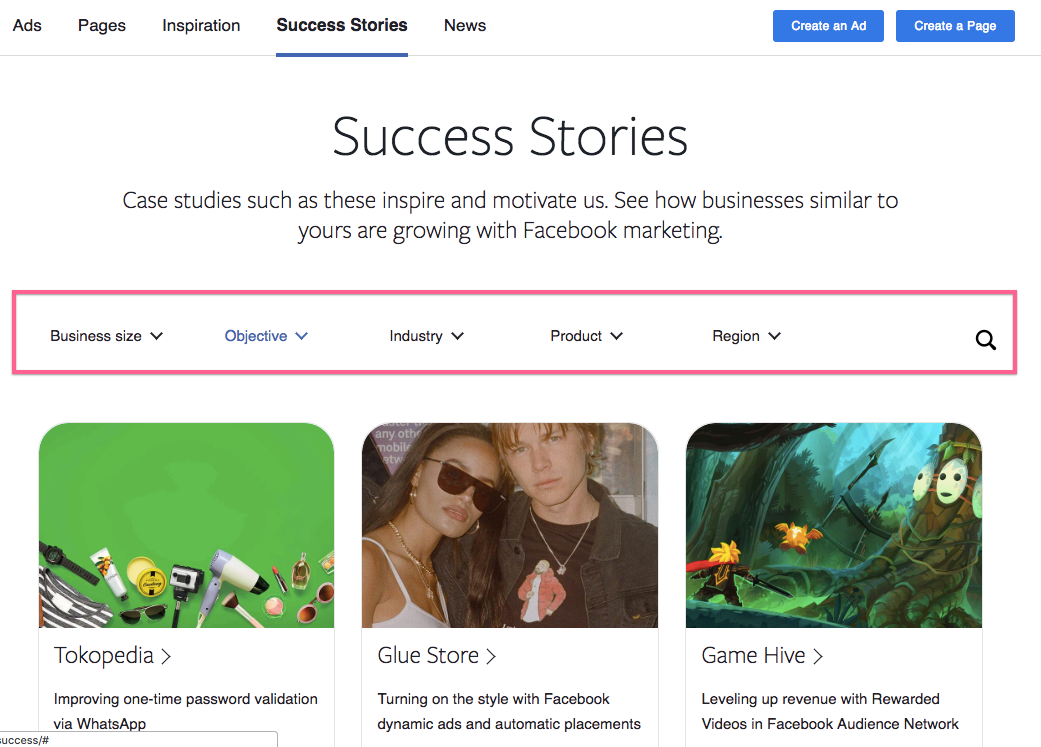
Step #2: Ask the company or client if they’re OK to be featured in a case study
You can’t feature a client in a case study unless they allow you to do so.
Besides, you also need information and quotes from the clients to use in your case studies.
So after identifying a few case study candidates, email them seeking their permission to feature them in a case study.
If you’re an agency looking to create a project case study, use this case study permission seeking template:
Hey there,
Thanks so much for choosing us to work on your project X. We thoroughly enjoyed working on it.
I was wondering if you’d be open to letting us do a case study on your experience of working with us.
If you’re okay, I’ll send you a few questions that you can answer to help us create the case study. I’m happy to do the interview on phone if that’s what you prefer.
Thanks,
X
Alternatively, if you’re a SaaS or IT solution provider wanting to write client success stories, use this client success story permission seeking template:
Hey there,
Thanks so much for choosing our service for your X needs at Company X.
I was wondering if you’d be open to letting us do a success story on your experience of working with our solution.
If you’re okay, I’ll send you a few questions that you can answer to help us create the case study. I’m happy to do the interview on phone, if that’s what you prefer.
Thanks,
X
Step #3: Prepare the case study interview questions
When preparing a questionnaire to send to your case study candidates, always remember to ask for only the information that just the client can give. Don’t ask questions you can find the answers to yourself.
Most importantly, the information you need from your clients for your case studies includes the different thoughts that they had when they were looking for a solution like yours, considering your solution (or service), comparing it with the alternatives, and the reason for choosing your company/agency over the other options.
Here are seven case study client interview questions that cover all this information:
- What got you to look for a solution/service like ours?
- What were your most essential expectations or needs from the ideal solution/service?
- How did you find our solution/service?
- What did you like best about our solution/service over the competitors?
- What have been the core things our solution/service helped/helps you with?
- How does our solution or service contribute to growing your business? For example — Does it get you more leads? Does it save you time? Has your conversion rate improved? Etc. (Always ask for a statistic if possible.)
- What would you say to a fellow company if you had to recommend our solution/service to them?
Step #4: Write your case study
After you’ve all the data from your client, you’re all set to write your case study.
Here are the sections that most standard case studies support: (Note: You DON’T HAVE to use the labels to introduce the different parts in your case study. But you should write your case study copy in the same order.)
Headline: A case study’s headline must be benefit-driven and non-salesly. Typically, most case study headlines take one of these two templates:
1. How Company X used [Solution] to [Get Key Result]
2. Company X: [Result]
A case study’s headline must only communicate the most important benefit the client got from the solution/service.
For instance, Filestage helps clients boost productivity, save time, deliver faster and so on. However, for one case study headline, only one of these benefits should be included (based on the client’s fundamental need).
Customer background: This is a 3-6 sentence section that introduces the featured company. Talk about the products or services the company offers, its team size (if it makes sense), its location, and target customers.
Challenges: This section introduces and explains the featured company’s challenges as they relate to the products or services you sell. Here, you should talk about the impact that the difficulties had on the company’s business. Pick 2-3 key challenges. Use many client quotes from your interview to beef up this section.
Journey: Here, talk about how the featured company realized the gravity of the challenge(s) they faced and how they struggled to resolve them. Discuss how they moved closer to finding the solution (your product or service) to their challenges. Give details about their shortlisting criteria and evaluation process. Again, use many of the client’s quotes to make this section more relatable.
Solution: This is the part where you introduce your solution or service and explain its key features and benefits that help with the challenges the featured company faced.
Implementation/onboarding: Here, talk about how easy or simple your solution’s implementation (or the onboarding process) was.
Results: This is where you talk about the results your solution or service got for the client. Always, match the results your solution or service got with the company’s challenges, otherwise, the readers might feel lost.
For example, a common challenge Filestage’s customers face is the time lost in feedback loops. So as a result, our case study could say, “With Filestage, Company X brought down their average feedback time by 70%“. Having a number for this section makes sense.
Step #5: Seek approval from the client
After your case study is ready, show it to the client to get your client’s approval. Here’s a simple case study approval email template you can use.
Hey there,
Thanks so much for working with us on the case study.
Just finished working on the draft — you can preview it here [link].
Please let me know if you need any changes. If not, we’ll go ahead with the publishing.
Thanks once again for making the time.
Best
X
So those are all the steps to writing a winning case study.
A few quick case study writing tips
If you follow the case study writing steps from above, you’ll have a head start. However, if you want to make them more effective, follow these case study writing tips:
- Avoid writing more than 1,000 words: Most B2B buyers don’t have much time. If your case study sits at 3000 words, they’ll probably not read it. So keep your case studies short and snappy.
- Use lots of customer quotes: To your case study, add as many quotes as possible from your client’s (interview) responses. Client quotes make the case studies much more human, relatable, and engaging.
- Don’t forget the snapshot: Always add a snapshot to your case studies. A case study’s snapshot is a sidebar that contains its most important information like the client, their problem, the solution, and the results. Add a customer quote if you’ve enough space. (See examples in the next section.)
- Call to action: At the end of your case study, write a call to action telling the reader what they need to do to get similar results as the featured client got. Without a call to action, the interested leads might feel lost about what to do next.
Some excellent case study examples
Here are three simple yet very effective marketing case study examples. You’ll be surprised to see that although the different case studies look different, they’re more or less using the same case study format from above.
Nielsen: Collaborating across 100 countries for better consumer insights
This Gsuite case study follows the same structure as listed above. It starts with the company’s introduction followed by the challenges, journey, and solution all the way up to the results. When you check out this case study, pay attention to the snappy subheads that introduce the different sections.
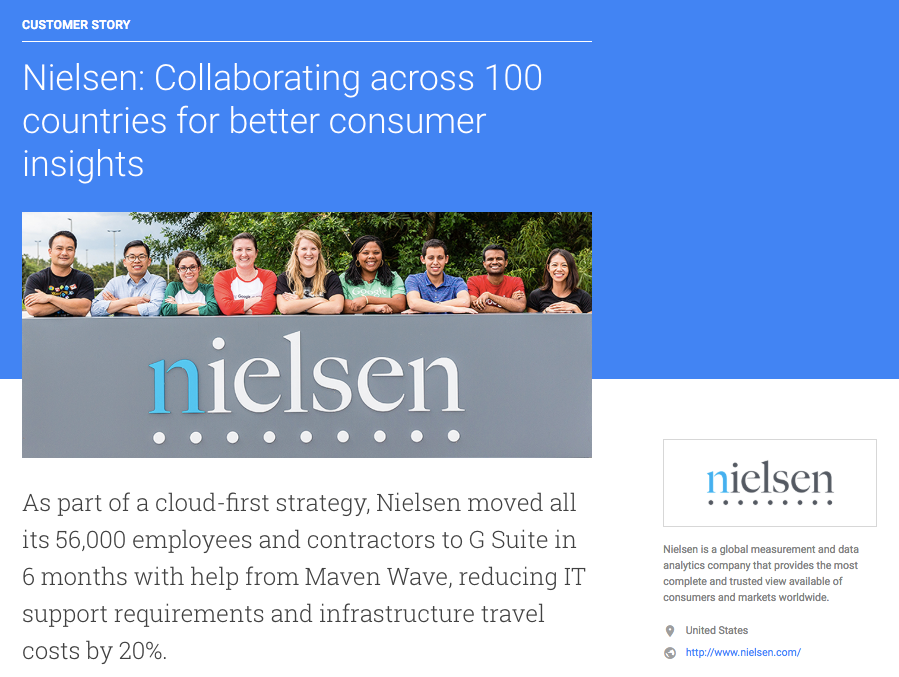
Case Study: How Weebly Saved “a Million” Hours on Content Production and Achieved a 3X ROI
This Contently case study also follows the traditional case study format. It also uses the typical labels like Challenge and Solution. In addition to the common case study elements, Contently has also included a call to action to guide the leads on their next step.
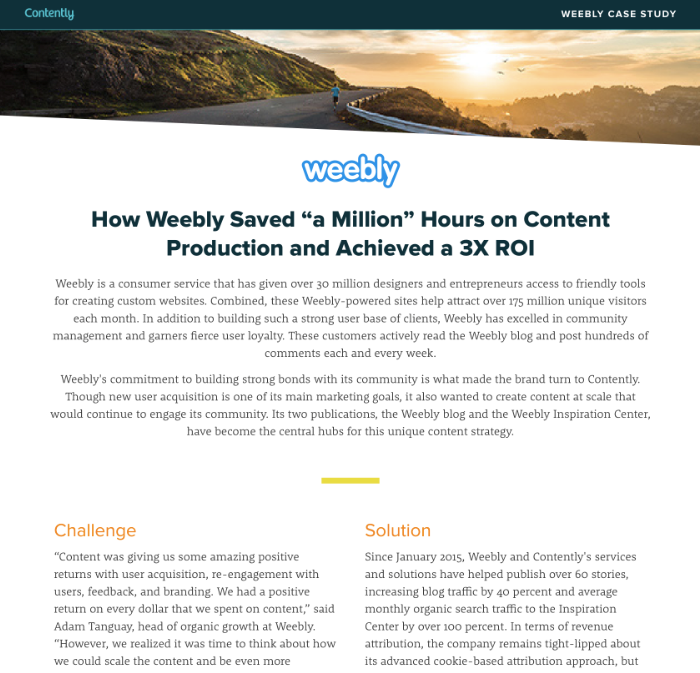
Banco MAIS works with IBM Business Partner Habber Tec to implement the IBM Business Process Manager on Cloud Service
This IBM case study also follows the traditional case study template. It’s bold and colorful and makes some great use of the sidebar (or the case study snapshot) with client’s quotes, call to action, and results.
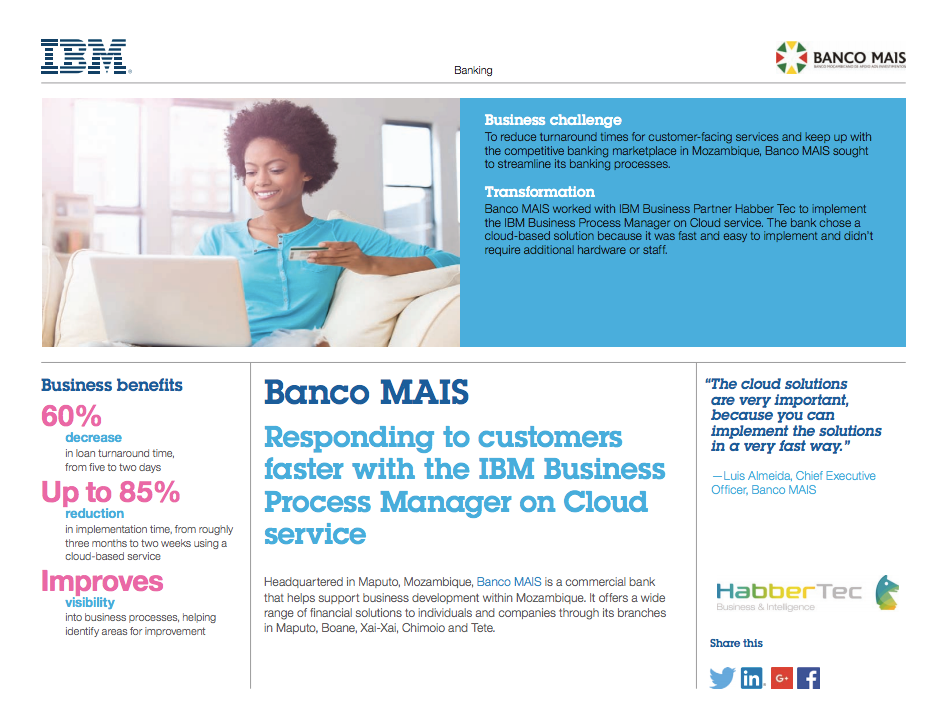
Following the same template as these companies, even you’ll be able to write excellent marketing case studies.
A few engaging case study formats
Most companies that produce case studies publish them as blog posts on their websites inside the “case study” category.
But you add much more life to your customer success stories by using different formats. Here are three of them.
Custom-designed PDFs: Once you’ve got an approved case study copy, instead of uploading it to your website, send it to a graphic designer to make it beautiful. A good designer can bring your case study to life by adding slick fonts, branding, colors, callout boxes, quotes, icons, images, and more.
If you don’t have the time or budget, you can use some catchy editable text graphics templates from Canva and repurpose them as beautiful visual case studies. You can then embed your case study PDFs on your website.
Custom case study website pages: If you use a page builder, or if you’ve access to a web designer and developer, consider building custom case study pages. Creating a custom page for your case study lets you add rich visual elements to it. Just look at this beautiful case study page from DesignStudio:

It has gorgeous images, videos, interactive elements, sliders … and creates a visual splash.
Video case studies: Agreed: Creating a video case study is a completely new game, but it has some great benefits. To start with, just a 2-minute video case study can convey more information than even a 10000-word case study might fail to share.
Look at this super-fun video case study from Zendesk to get an idea:
Conclusion
Once your marketing case studies are ready, put up a case studies page on your website that lists all of them.
Add a link to this page in your website’s footer or under your menu’s resources’ tab. Also, promote your case studies in your lead generation email campaigns. And don’t forget to tell your sales team about your case studies as they’ll be the one sharing it the most with their best leads.
Have you written any marketing case studies for your company? Drop them in the comments – we’d love to take a look!
Are you interested in other templates?
- The Only Project Plan Template You’ll Ever Need (incl. 6 Examples)
- Effective Buyer Persona Template

